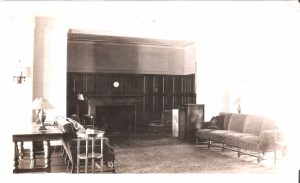History
History of The Rensselaer Society of Engineers, Inc
In early 1866 several Rensselaer students, dissatisfied with their student government and the other student groups available to them, decided to form a new type of social and academic organization. After meeting several times they decided to call themselves the Panto Hericas Society or The Pi Eta Scientific Society. Under Society’s constitution, candidates for membership were nominated and voted upon by members of the Society. Upon initiation, new members were expected to pay a small initiation fee and thereafter regular membership dues which supported the rental of meeting rooms in various locations around Troy.
Early meetings were often characterized by the reading and discussion of scientific and engineering papers as well as guest lectures by professors from Rensselaer and other local colleges. In addition to students being eligible for membership in Pi Eta, honorary membership was extended to any graduate or officer of Rensselaer or any other person who had distinguished themselves in their scientific endeavors. Despite its modest, informal beginnings in early 1866, the Society held its first officer election in May 1867.

Pi Eta Scientific Society

In 1867, the Society created a library to collect scientific and engineering publications in addition to original works by members. Today the library continues to be housed in the Society’s clubhouse. A model of diversity at the time, the Society counted among its members students from across the United States, Central and South America as well as Asia, including some of Rensselaer’s first Japanese and Chinese students.
The Pi Eta Scientific Society was formally incorporated in 1873; its name was subsequently changed to The Rensselaer Society of Engineers, Inc. in 1883. The intent of the name change was to distinguish the members from the rising numbers of Greek letter fraternities in the region as well as to show their close ties with Rensselaer Polytechnic Institute. Among the Society’s early strengths was its ability cultivate strong personal and social bonds between its members. It was because of these bonds the Society able to develop a pipeline for new graduates to find employment opportunities in some of the most advanced industries of the time. In a time before the large professional societies and social networking, The Rensselaer Society of Engineers created an academic society that also fostered close personal and professional ties between its student members, alumni, and involved Institute faculty.
RSE Clubhouse History
A major fire in 1904 required the Rensselaer campus to undergo major changes including a period of expansion and curriculum diversification. The student population expanded. RSE looked to the future and anticipated the need to build a clubhouse to house its growing membership. The idea of a clubhouse, potentially with dormitory style living quarters was first formally discussed at a 1909 Society Meeting. The possibility of acquiring land on 15th street was also considered. It was determined that the student population was still too concentrated in downtown Troy; the project would be delayed until it became apparent that student housing preferences were bringing them up the hill and closer to the growing campus. Historically, the Society had occupied the following locations:
- Prior to April 1868: Rented rooms belonging to a Dr. Watkins
- April 1868 – 1870: Unknown Location
- After 1870: Hannibal Green Building, Broadway, Troy NY
- Before 1881: 4th Street, Troy, NY
- 1881 – 1908: 219 River Street, Troy, NY
- 1908 – 1920: 257 Broadway, Troy, NY (second floor above a bank – three rented rooms)
By 1912 student living preferences had indeed changed as expected leading to the formation of a building committee. The building committee eventually authorized the 1915 purchase of a lot on the corner of Sage and Griswold Road across from the new quad dormitories. Fundraising efforts for the Society Clubhouse slowed following the purchase of the lot. In an effort to compete with other student organizations and fraternal organizations offering housing, the Society purchased a smaller house on Burdett Avenue, adjacent to Samaritan Hospital. Junior Members had to develop rules and expectations for their new living situation, a new challenge for the members. The Burdett Avenue house did not fully satisfy the needs of the Society. It did make RSE among one of the first four fraternities on campus to own their own house.
RSE members had found a new home on Burdett Avenue. The fund raising effort to build a house on the vacant property on the corner of Sage and Griswold continued. Many alumni had donated but ultimately a donation from Pittsburgh industrialist and philanthropist John M. Lockhart of $100,000 proved to be sufficient to begin construction in 1923. Famed architect Bertram Grosvenor Goodhue was chosen to design the house. The exterior of the house was designed using red Harvard with limestone trimmings similar to the new buildings constructed on campus during it rebuilding following the 1904 fire. However, as construction progressed it became evident that more funds would be necessary. To support the completion of the clubhouse Lockhart made a subsequent $100,000 donation.
The completed House was formally dedicated on June 12, 1924, with alumni coming back to Troy in force for the occasion. It was not until after Lockhart’s death in 1939 that it was disclosed that he had not only been the largest donor to RSE Clubhouse building effort but with donations exceeding $5.6M he had also been Rensselaer’s largest benefactor during its reconstruction. (His donations had been made under the pseudonym “Builder”.) RSE’s close proximity to campus was further cemented in the years following World War II with the construction of freshmen dormitories on Freshman Hill to support the growing number of students taking advantage of the GI Bill, many of whom also chose to join RSE and live in the Clubhouse.


